Summary
- We chat with Composer Kris Maddigan and Studio MDHR Creative Director Chad Moldenhauer about the collection of brand-new songs for Cuphead – The Delicious Last Course.
- From navigating COVID to some outstanding performances from their musicians, the newest soundtrack rivals some of gaming’s best.
- Cuphead – The Delicious Last Course is available for purchase today on the Xbox Store for $7.99. It’s also available in the Cuphead & The Delicious Last Course bundle for $26.99.
Adorned on my office wall is a modest collection of video game music on vinyl. It features some personal favorites like Grim Fandango, Skyrim, and The Legend of Zelda: Ocarina of Time. Now after hearing a sampling of the latest music for Cuphead – The Delicious Last Course, there is a spot reserved for this upcoming collection of delightful songs.
The original Cuphead soundtrack features a diverse mix of big band, 1930s jazz, and a barbershop quartet to accompany Cuphead and Mugman on their wild journey across the Inkwell Isle. Today, Composer Kris Maddigan is serving up a glorious new collection of songs (a delicious last course, if you will) for this latest platforming adventure, featuring themes that call back to the original game and chart a path for its newest hero, Ms. Chalice.
To learn more about its creation, we chatted with Kris and Studio MDHR Creative Director Chad Moldenhauer about returning to the world of Cuphead, the challenges they faced recording music against the backdrop of a global pandemic and praising the many musicians who contributed to what’s destined to be another modern classic for everyone to enjoy.
Xbox Wire: Thanks for taking the time to talk. I’m curious to know how challenging it was, creatively, coming back to Cuphead and creating a wholly new soundtrack that’s capturing both the spirit of the original game, while also charting a new path with the composition for Cuphead – The Delicious Last Course?
Kris Maddigan: I think considering this was originally supposed to be out in 2018, I didn’t really feel like I left the world for very long. I was kind of already brainstorming ideas for what I wanted to do on this next game and already sort of knew some of the musical areas that we didn’t explore the first time around. So, I feel like I haven’t left it in about 8 or 9 years now in a sense. It was quite easy just to stay in that realm, but it was just branching out to other areas within that.
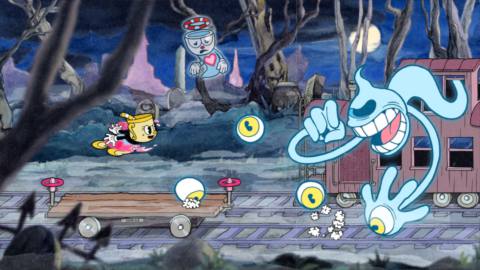

Xbox Wire: The experience of composing the musical tracks during the pandemic must have been challenging to say at least, having to layer all the tracks together from different musicians across the country. I imagine that all of that must have been very difficult.
Kris Maddigan: Yeah, I mean, just the actual recording process itself. Most people with the exception of our organ and harpsicord player who has a giant home organ rig, which is like, you know, a full size with manuals and stops and everything, which is not particularly portable, he recorded his stuff at his house and because we have some barbershop stuff, they were split up… So, two of those guys were recording in Buffalo because they couldn’t cross the border and two of the guys were here. But aside from that, we didn’t do any recording outside of the three local studios that we recorded at.
The challenges within that were there were certain rules, like we couldn’t have more than 10 people on a session at a time, and so we utilized the three sort of big major studios in Toronto: Canterbury, Noble, and Revolution Studios for solo stuff. The big band rhythm section we did at Canterbury. Big band horns we did at Revolution because of the size of the room, we could space them out a bit more and the big challenge was just logistically sort of figuring all that out.
Huge, huge props go to Jeremy Darby, who was our recording engineer on this project, because he was kind of the one who did all the math for where everyone needs to be spaced, and where we’re doing this sessions, and this is where the mics need to be… If you watch the behind-the-scenes video that came out in December, the recording of the overture, there’s a part where you see all three strings sections layered on top of each other. And that’s three different sessions from the same camera angle. And you see how the chairs are all shifted so that the sound still sounds like it’s 30 people the way they would normally be spaced as opposed to 10, 10, and 10. So I mean, really that was the big thing. Trying to make that sound cohesive because that’s not a practical way to record, especially over that many different locations.
The other big challenge that we ended up running into was when you do something like that, say, if you’re going to record a 50-piece orchestra, you might book a concert hall and then you would do one session to record. Because we couldn’t do that, the 50-piece orchestra had to be done in five sessions, which at that point is five times the amount of mic tracks that is required for Pro Tools. I don’t remember the exact numbers that Jeremy had for the session data, but we had to procure, I think it was about $7,000, for a special HDX card, just so his very high end Pro Tools computer could actually handle all of the tracks that we were putting into it, which he’s never had to do before. Everyone in the audio industry who heard that we had to do that was in disbelief because that’s kind of unheard of, like just hundreds and hundreds and hundreds of tracks.
We could not have done it without Jeremy. Within that context, it was still very ordered and methodical. It was just a lot of big groups of players broken down into small groups. I think if you’ve heard it already or when people hear the soundtrack, you would never know that that’s how we had to record it either, unless you actually knew that.
Xbox Wire: When you’re going about composing the themes for both the returning characters and some of the new ones that you experience in Delicious Last Course, are there other video game soundtracks or works of music that you hear and you want to emulate?
Kris Maddigan: Yeah, I mean, I think the game itself is a lot of homages to things, and that’s kind of one of the things that the game does. And musically, there’s a lot of little video game quotes that are in there from other games that I like or things where Chad’s like, “You got to put this put this Golden Axe riff in there somewhere,” which I did. I had to like play with it a bit to make it work but…
Xbox Wire: Which track does that show up on?
Kris Maddigan: That one is called, “Gnome Way Out.” I think it’s been surgically altered enough in order to make it fit. But there’s still quotes from the first game that no one has discovered yet, to my surprise.
There are the standard game soundtracks that I grew up with that I find really inspirational, like particularly Final Fantasy 7, which is such a cliche to say. It’s a great soundtrack, but that was really the one for me that’s arguably the most operatic of Nobuo Uematsu’s work, because of the thematic development and his use of themes and light motifs. Like, obviously there’s a lot of great soundtracks, but that is his most cohesive work, I think.
And so, I found that was something that inspired me on this because it’s a run ‘n gun game. It’s not really like hours and hours of story, but I was really trying to create a soundtrack that actually had sort of a narrative arc that goes through it. It’s “X-Files” episodes. You can just tape the lore episodes and watch all of those, and they’ll have a cohesive story experience, but it’s all the episodes which are standalone episodes also. You know the DLC has the lore soundtrack, and it’s also got the standalone tune. And hopefully, that comes through. If you sit down and listen to it start to finish, you’ll start to hear those themes and the development. And then when you play the game and know the story, it will hopefully make a bit more sense. But I was trying to do something that I think was very challenging, which was create a cohesive narrative soundtrack for a run ‘n gun game.
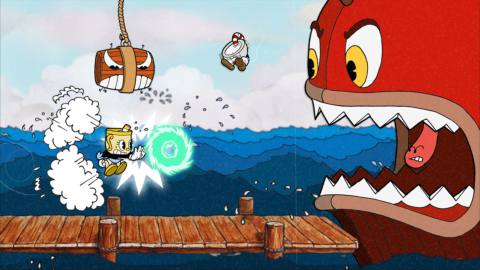

Xbox Wire: Were there particular instruments that you lean on to set a mood or set a theme or ones that you like to use more often to kind of help convey what the action might be on the screen?
Kris Maddigan: Yeah, I think there’s a lot more orchestral instruments in this one than the last one. Like the violin, sort of guitar, Hot Club of France sound. I wanted to write more in that style, and I think that instrument combination becomes its own character in a sense on the soundtrack. Also, like when you hear those instruments, it’s sort of trying to make things coherent a bit more obviously. So, I mean, there’s a lot of guitar and violin on the soundtrack in that context.
I also wanted to use a big church organ, which is kind of a cliche in some ways, and I wanted to just do it so over the top that no one will ever want to use that instrument ever again. Whether I succeeded, I don’t know, but it was just more of a challenge to be like, “How can we really take these ideas and just really like make them huge?”
There were other instruments. I was also just trying to find more unique instruments that we hadn’t used before. There’s a strange, fairly uncommon saxophone called the Sea Melody Saxophone, which was popular in the ‘20s and ‘30s and then kind of fell out of favor. And there’s not very many of them lying around. We managed to find three of them. So, there’s one tune on here that has three Sea Melody Saxophones on it, which is a very strange sound. There’s a novachord on one tune, which is a very early Hammond organ, and you’ll hear that the first time you meet the Blue Fairy in “Pinocchio.” That’s the novachord, which is a very sort of otherworldly sound that they used in that soundtrack. That was another interesting sort of instrument.
There are some instruments which are more their own characters. They’re defining characters, but also just trying to find all of the other sort of obscure sounds and instruments that we didn’t use the first time around.
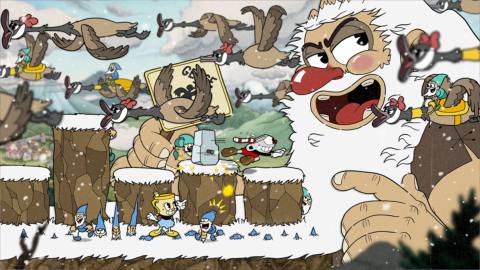

Xbox Wire: When you go about composing an original score for a boss fight, do you start collaborating with the team as they’re starting to illustrate the character, or do you approach them with a sample that in turn helps them draw the inspiration to create that character? What’s that back-and-forth relationship like?
Kris Maddigan: I mean, I think that I’m probably more inspired by the visuals than they are by the music in terms of creation, but this time around, much more so than the first. The first game, it was very much… I was just trying to put down as many ideas on paper as was possible because there was seemingly more and more work every day and more bosses.
So, it was just, I’m just trying to keep up with that and then often what would happen is Chad would say like, “Oh, this tune sounds like it would go good with this boss.” And then I might go back to it and then maybe tailor it a bit more to that particular boss, like “Phantom Express” is a good example of that, where it kind of had a good vibe. And then Chad was like, “oh, this could be the train boss.” And then we went back and added some train sounds to it and that kind of thing.
In the first game, some of the bosses were tailored specifically, but a lot of them we were working on simultaneously and then mixed matched them together. Whereas on this one, almost entirely across the board, the whole soundtrack was designed specifically for specific bosses or specific areas. I saw a lot of the art pretty early on or it was described to me, and I think that there was just a lot more thought put into really matching the music to the visuals in this case. But I would say I was very inspired by what I was seeing visually for a lot of the tracks.
Chad Moldenhauer: The first game was kind of almost directly followed, unbeknownst to us, how Street Fighter 2’s music happened. The composer is writing all the music, and as people were finishing the backgrounds and art they came in and said, “Oh, that’s going to match this background and this one’s going to match this fight!” The first game was so different because like Kris was saying, the scope was never actually clear and stuff was changing all the time to the point where we might have described a boss as a giant mining boss, that’s deep in the coals and Kris is working on some stuff. And we go, “Ah that boss was scrapped. It was changed into a genie.” Kris goes, “oh OK, cool.”
Kris Maddigan: Actually, I think that the genie one was specifically for the genie.
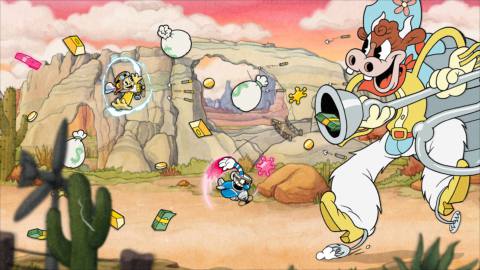

Xbox Wire: So, for Delicious Last Course, were there any particular compositions of boss fights that really stand out for you either how challenging or how or how natural that collaboration came together?
Kris Maddigan: I mean, there were a few tunes which were harder to finish than other ones like, the video is already up for this, the Mortimer Freeze Snowcone Scuffle. I was like 90% done on it for a long time and it was just getting the cords exactly right. It was really tricky.
There’s another boss fight, a big bad boss fight that was the same. I won’t say which one, but you know there were a couple of tunes. A world map theme also just took forever to get the voicing how I wanted it to sound. There was a bigger challenge that way of just really refining it and getting everything exactly how I wanted it to be. And sometimes that takes a long time and sometimes it doesn’t. I learned so much on the first game, but it doesn’t really make the composing process easier. In a sense it just makes it so that you can solve problems quicker, but you just have different problems that you must learn how to solve.
Chad Moldenhauer: Yeah, and there’s a few places in the soundtrack where we cut from one track to the next, which brought its own challenges for how you were going to make it sound because it was never timed perfectly, it just kind of had to jump out.
Kris Maddigan: There’s some stuff like that too, and part of the challenge was even though everything was pretty locked in, just booking studio time during COVID was such a hassle, because again you have to book 5, 6, 7, 8 times as much time as you might normally have to do and that’s challenging and it takes a lot of scheduling and making sure everyone’s free and this and that. Most of this was recorded between May and I think, like August of last year.
Part of what Chad’s talking about, like if that changes within that, well the music’s already done. So, we sort of have to be like, “OK well how do we finesse that now that it’s finished into something that works,” which is, I mean, that was maybe one of the only parts I think that was kind of an issue, I think. There’s definitely at least one part where the visuals had to be made to the music, I think.
But yeah, it would have been nice to maybe delay the recording a bit more, but we found ourselves with these windows where people were free, and it seems like we’re not at the top of some (COVID) wave, so it’s a bit safer and we’ll try and get everyone in in a couple of weeks. We were supposed to do everything in May. I think last May was just going to be absolute recording hell. And then we ended up having to postpone just because it was a comfortableness thing. Like we had to postpone anyone who blew air into an instrument. We postponed all of that until August was when we did the big band brass and the orchestral brass and winds.
When we started, it was when they were just getting vaccines out. So, we were trying to figure that out too. It comes down to if people are not comfortable being in the studio, they’re not going to play great. We did not want anyone to get sick and nobody did. Which is amazing and fantastic. It’s not amazing because we were very strict, and we had tested every day with the nurse and UV light and stuff. It took a lot of effort to keep everyone safe and feeling that good, but people were going to feel a lot better at the end of summer after getting the vaccine. Then also if you’re in a situation where you’re just not comfortable being there, you’re not going to do your best work, and we wanted to make sure that everyone also was comfortable being there.
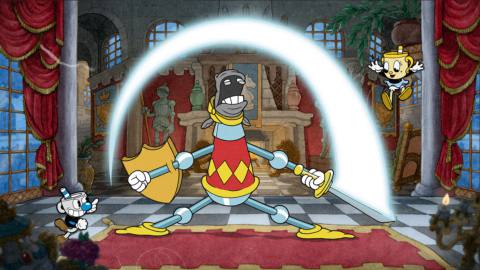

Xbox Wire: Speaking of your musicians, were there any particular performances that blew you away as you were going throughout the creative process? For me, when I was listening to the sampling, whoever is on the xylophone for “Recipe for Miss Chalice” was amazing.
Kris Maddigan: Well, by the time this interview comes out, there may be footage of Michael Murphy playing that xylophone part. I’m just saying, that’s a hypothetical. Who knows? But yeah, every single musician on that soundtrack brought it, and they showed up. The last time (Cuphead) we had rehearsals and this time we were like, rehearsals are just one more complication, because we would need to round up a rehearsal venue, then do the same testing, like it was already so much work. So, we just asked people, you know, please really look at the parts and show up to be ready to go and everyone showed up so incredibly prepared and just played the hell out of their parts. It made the recording and editing process very easy in a lot of ways, but there are certainly a few folks that stand out.
I mean, Mike Murphy is one of them. Drew Jurecka, who you see on the “High-Noon Hoopla” video playing fiddle. He was a bit of a secret weapon on a lot of these tracks and incredible ear and very knowledgeable guy to ask questions to. He’s got all the answers. Possibly one of the best whistlers you will ever hear. Phenomenal whistler.
Sonia Eng also, she’s the harp player that you see on the overture video from December. I wrote a piece that features her, and I think when you listen to the soundtrack, you’ll figure out which one it is. But I didn’t think that it was really going be playable in one pass. I thought we would have to split it up. Harp is a very challenging instrument to write for and there’s a lot of things you can’t do on harp, like, really chromatic things because of the way that the tuning works and someone like Ravel would write harp parts that sounded like one player, but they were two players because they would have to switch off every bar because of the pedaling.
Anyways, this particular track, I told Sonia we can break it up however you want, and we’ll do whatever sections that you want to do and then we can stop. And she played the whole piece start to finish in one take and Julian and I were in the in the booth and we were just like absolutely floored, like it was stunning. And so, her performance on that track was incredible.
Anyone who had a leadership role like Sharon Lee, who is the concert master of the orchestra, played first violin, she did a lot of string bowings and string organizing, anything like that. So, she was really a super great asset to have and sounded great. Stephen Boda, who recorded organ and harpsichord from his house, and it sounds like this cathedral. So, there’s some standard performances, but every single player does some incredible playing on that thing.
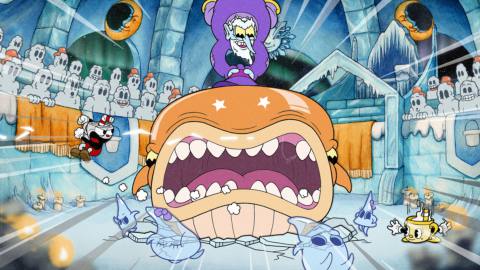

Xbox Wire: If this is the last time we’re seeing Cuphead, Mugman, and Miss Chalice, what will you miss most about this experience with the game and its characters?
Kris Maddigan: Hopefully, I get to work more with MDHR, but I think it was that they had a sound that they wanted, but they also gave me a lot of freedom to pursue any wild, challenging, and expensive ideas that I was thinking of might be fun. The support from the studio made the recording process and the writing process very enjoyable because I felt that I didn’t really have certain limitations which would have been maybe frustrating to deal with, I guess. So being able to write in that style and learn about a lot of those styles and spend time there and not have to also be thinking about how I am going to cut corners on this or that kind of thing, I will certainly miss that going forward.
But obviously it’s also an incredible era for music across the board. So, it’s been a pleasure spending time there and really digging into it and I hope that people enjoy this soundtrack when they hear it. It’s been almost as long to write this one as the first one, maybe even longer so in theory, I hope that that shows in the final product.
Chad Moldenhauer: I just think like, internally, for the entire game we tried to push this Cuphead DLC to our limits, since this 1930s era might be an era we don’t come back to for a very long time. So, our goal behind it was like let’s just push our limits to it and we may have pushed it too far and delayed the game a few times. But the same goes for the music too. Like Kris just jumped into this and took it to new awesome places and you know, bigger sound and just everything kind of this over-the-top way that I think. I think all of the fans who enjoyed Cuphead will kind of see this, this not really a love letter, but our kind of, farewell finale?
Kris Maddigan: Yeah, definitely. The first game sound is in there, but this is also its own sound world and I think it’s very extravagant and lush. Assuming that maybe we’re not going to be living in this world for you know how many more games to come, that was an impetus to really put a nice, proper bow on this whole experience.
Xbox Wire: Yeah. It’s awesome. I’m really looking forward to playing the final game and hearing the final soundtrack because your work has been incredible. Both with the first game and then of the sampling that I’ve heard so far of Miss Chalice. I’m looking forward to it. I know tons of people are and I just want to say thanks again for making the time and sharing your experiences here.
Kris Maddigan: Hey, thanks for chatting.
Chad: Yeah. Thanks for having us. This was awesome.
Thanks again to Kris and Chad for making the time to chat. You can pick up Cuphead – The Delicious Last Course for purchase today on the Xbox Store for $7.99. It’s also available in the Cuphead & The Delicious Last Course bundle for $26.99.
Cuphead – The Delicious Last Course
Studio MDHR




Cuphead
Studio MDHR


Cuphead & The Delicious Last Course
Studio MDHR
Related:
We Savor Cuphead – The Delicious Last Course and Want Seconds
Embrace a Love for the Classics with the ID@Xbox Retro Sale
A Quick History of Indie Games on Xbox and a Look Forward with Over 2,000 Games Shipped via ID@Xbox
Source



